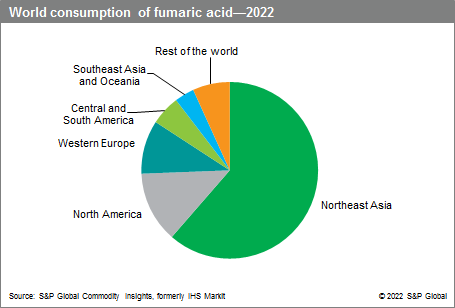Published November 2022
Fumaric acid (trans-2-butenedioic acid) is a multifunctional chemical with a diverse set of end uses, including unsaturated polyester resins (UPR), food and beverages, L-aspartic acid, rosin paper sizes, animal feed, alkyd resins, and pharmaceuticals/ferrous fumarate. The following chart presents global consumption of fumaric acid by region in 2022:

UPR is the largest end use for fumaric acid in 2022. Demand for UPR is strongly dependent on construction/remodeling activity (residential and nonresidential) and motor vehicle production. Global consumption of fumaric acid in this end use will grow more slowly than demand for UPR itself because of competition from maleic anhydride in this application.
The food and beverages segment is the second-largest end use for fumaric acid. In food and beverage applications, fumaric acid serves primarily as an acidulant; it is used to adjust pH, enhance flavor, and extend shelf life by controlling the growth of microorganisms. Expansion of this segment will be driven largely by demand increases in mainland China, India, and Southeast Asia. In other regions, food and beverage applications are comparatively mature, and consumption growth will be steady but moderate.
L-Aspartic acid production, the third-largest end use for fumaric acid, is expected to see the fastest growth during the forecast period. L-Aspartic acid and phenylalanine are the key building blocks for aspartame, a zero calorie high-intensity sweetener that is widely used in diet soft drinks and other low-calorie foods. Mainland China is the largest producer and consumer of L-aspartic acid.
For more detailed information, see the table of contents, shown below.
S&P Global’s Chemical Economics Handbook – Fumaric Acid is the comprehensive and trusted guide for anyone seeking information on this industry. This latest report details global and regional information, including

Key Benefits
S&P Global’s Chemical Economics Handbook – Fumaric Acid has been compiled using primary interviews with key suppliers and organizations, and leading representatives from the industry in combination with S&P Global’s unparalleled access to upstream and downstream market intelligence and expert insights into industry dynamics, trade, and economics.
This report can help you
- Identify trends and driving forces influencing chemical markets
- Forecast and plan for future demand
- Understand the impact of competing materials
- Identify and evaluate potential customers and competitors
- Evaluate producers
- Track changing prices and trade movements
- Analyze the impact of feedstocks, regulations, and other factors on chemical profitability


















